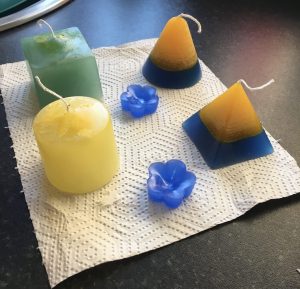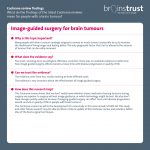Crafting helps Sarah to manage her brain tumour anxiety
We’re advocating for creativity this Brain Tumour Awareness Month as we explore self-care for people living with a brain tumour. Sarah shares here how being creative has helped her to cope with her brain tumour diagnosis, and what other benefits she gets from crafting.
If you’d like to explore your creativity, come along to our next Art Time workshop in April!
The Great brainstrust Create-Off is our competition allowing people with a brain tumour to showcase their creative masterpieces. Open to all abilities, submit a piece you have created for a chance to win some prizes and feature in the brainstrust 2022 calendar. The deadline for submissions is the 31st March!

What sort of creative activities do you enjoy doing?
I have always enjoyed baking and decorating cakes, I always do cakes for my family’s birthdays.
A few years ago I went to night school to learn floristry at the College I worked at, that was two hours a week that I found so relaxing as it was away from screens and the stresses of life and you could just sit and chat and learn a new skill.
I taught myself from a kit how to make candles and from trial and error how to decorate bottles. I like making cards and I have taught myself since my brain surgery how to do die cutting and glass painting.
How did you find they helped you following your brain tumour diagnosis?
I have always liked doing crafts, but having that escapism really helped me when I was going through such a stressful time.
It’s very easy to sit and worry, so putting my energy in to making things and learning new things really helped to relax my mind. It gave me something to focus on rather than the worry of all the scans and then knowing I was going to have to have surgery to remove the meningioma.
I also liked going out for walks and taking my camera with me, I took lots of photos of animals, birds and scenery and then this gave me the idea of putting those into a calendar that I then had printed for Christmas presents for people, which is now something I do every year.

How does it make you feel once you have completed a new creative project or tried something new?
It makes me feel happy, especially if I have made something for someone as a gift. I have made a few presents now for people, and they always say how much they love them as I’ve taken the time to make something I think they would like.
I like to try new crafts, some are trickier to do than others but when you’ve made something and you’ve almost taught yourself how to do it, it does make you feel proud. I really struggled after my brain surgery to be able to follow instructions or to think of what I wanted to make, but that has turned in to a really good tool for recovery because it was a challenge and it made me learn new ways of understanding, and when I look back on how I have improved, that has helped my confidence.
What would you say to other people with a brain tumour who are wanting to start a creative activity but are unsure?
I would say go for it, there’s so many different types of crafts now that you are bound to find one or two that you really enjoy and there are so many resources available online that will help get you started. I have found lots of helpful tips online and have found YouTube quite handy as it’s helped me to see something visually to then go and try it out.
I’m not an arty person, I can’t draw anything but from trying things out and taking inspiration from things around me I can make things and when you do it gives you such a sense of achievement.
I would also say take photos of the things you make and then every now and again look back at them and you’ll be surprised at how much you’ve improved and how far you’ve come.





